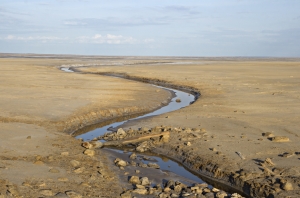
An arroyo is a dry river bed or seasonally active creek. They are usually found in deserts or other arid climates and completely dry up between periods of activity due to water-less conditions. They are filled with water and become active again after substantial rainfall and floods. Sometimes they can have vertical walls that cut into the desert with a gravel valley floor between the walls.
An arroyo can be a shallow stream bed covered with mud or sand. It may be dry with cracks in the surface. An arroyo can also be cut deeply, forming a narrow channel in the ground.
Arroyos are indicative of a river that formerly coursed through the area that is presently dry. Sometimes there are shrubs or bushes along the edges of arroyos that point to a possible underground water source. Most arroyos form as a result of flash-flooding in areas that do not get regular rainfall such as deserts. The flash flooding cuts through the dry ground to create these geological formations.
Arroyos are very common in desert areas. Occasional heavy rainfall can cause water to flow over the land, forming a stream bed when the water dries up. Dams can help to create Arroyos. During the dry season, the Salt River below the Granite Reef Dam in Arizona will stop flowing when the dam is closed to conserve water, forming an arroyo.
Parts of India experience heavy rainfall during the monsoon season which feeds the Mayrukashi, Bhurbhuri and Sabamati Rivers. During the dry season, these rivers dry up to form sandy arroyos in the ground. Arroyos are also common in many mountain areas.
They are formed during the wet season when water flows down the mountainside and through mountain valleys. When water isn’t flowing, arroyos in some regions are also the primary transportation routes for many people who live there.
Arroyos are also artificially constructed in some areas to prevent flooding during heavy rains in some cities and towns of desert regions. Farmers sometimes construct arroyos to control the flow of water to their fields and prevent flooding during heavy rainfall. Some cities of the Southwestern United States have built large arroyos that are covered with concrete. These provide a path for water to drain and prevent flooding from heavy rainstorms.
When heavy rain falls in the desert, the hard dry ground cannot absorb the water quickly. Flooding takes place very easily in the desert. A thunderstorm can create a flash flood very quickly, rushing through an arroyo and carrying away everything in its path. This can happen in a natural arroyo of the desert, or in an artificially constructed arroyo of a city. Signs are sometimes posted to warn of this danger.
A creek or river bed that is sometimes dry due to an inconsistent water source.
Another term for an arroyo landform is a wash.
We want pictures and location of the lanforms around the world and we need your help. Click get started button below.
In Asia, China, India, Nepal, and Bhutan are home to one of the eight wonders of the world and one of the most beautiful mountains in the world, the Himalaya Mountains also called the Himalayas. Boasting as the world’s highest and most famous mountain peak, Mt. Everest. Within the verse of the ‘Kumarsambhava’, Sanskrit […]
Nature have provided us with fascinating landforms and features. The most often adored landforms are volcanoes. Like the perfect cone structure of Mayon Volcano in the Philippines or Mount Fiji in Japan, people look at their beauty and wonder with great appreciation to nature. Volcanoes are mountains with a very disastrous nature. Their only […]
Taal Volcano is the second most active volcano found in the province of Batangas. A complex volcano in the middle of Taal Lake and is often called an island within a lake, that is an island within a lake that is on an island as well as one of the lowest volcano in the […]
Mayon Volcano is one of the active volcanoes in the Philippines. Located in the southern part of Luzon about 473 kilometers (294 miles) from Makati Business District of the Philippines, Mount Mayon is the main landmark of the Province of Albay of Bicol Region. According to local folklore, the volcano was named after Daragang […]
The global temperature and weather is to a large extent a direct result of the sun’s effect to our planet. Together with the atmosphere and the rotation of the earth on its axis. The earth on which weather moves on has its own effect on the weather. The different landforms like mountains, volcanoes, plains, and the […]